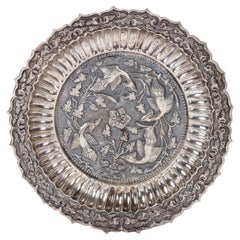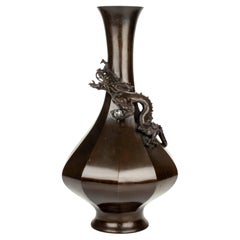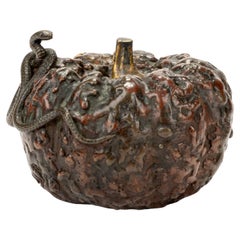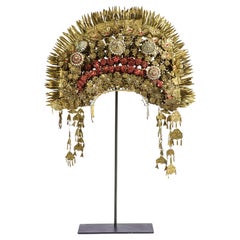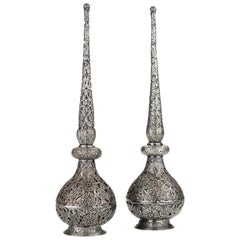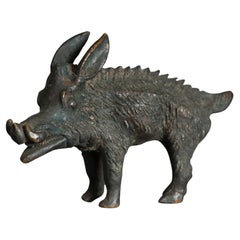Continental Europe - Metalwork
to
18
196
1,063
608
190
4
2
4
2
2
2
2
2
1
26
105
59
6
20
17
11
1
2
1
1
7
4
3
186
106
22
15
15
168
135
107
25
23
196
192
195
2
1
1
1
1
Item Ships From: Continental Europe
Fabulous Indonesian Yogya-Silver Plate
Located in Amsterdam, NL
An Indonesian Yogya-silver plate
Yogyakarta or Kotagede, 1935-1940, marked, (alloy) 800 and maker’s mark PH (Prawirohardjo, act. from 1935)
Diam. 27.2 cm Weight 454 grams
Th...
Category
Early 20th Century Indonesian Art Deco Continental Europe - Metalwork
Materials
Silver
A Japanese bronze vase with Ryū dragon in relief, signed Maruki Sei
Located in Milano, IT
A Japanese bronze vase featuring a Ryū dragon in relief, depicted as it grasps the sacred Buddhist jewel (tama).
Signed Maruki Sei in relief under the base, with a second engraved ...
Category
Late 19th Century Japanese Antique Continental Europe - Metalwork
Materials
Bronze
Bronze suiteki in the shape of a pumpkin with a snake, signed Masayuki
Located in Milano, IT
Suiteki, water dispenser, made of finely molded bronze in the shape of a gourd, with a snake coiled on one side.
Signed Masayuki.
Period: Edo 19th cent.
Dimensions: 7 x 9 x 9 cm.
...
Category
19th Century Japanese Antique Continental Europe - Metalwork
Materials
Bronze
An elaborate Minangkabau gem-set brass floral wedding crown or 'Suntiang'
Located in Amsterdam, NL
An elaborate Minangkabau gem-set brass floral wedding crown or 'Suntiang'
West Sumatra, Minangkabau, probably 1st half 20th century
H. 66.5 cm (incl. stand)
Provenance: Private co...
Category
Mid-20th Century Indonesian Continental Europe - Metalwork
Materials
Brass, Enamel
Pair of Fine Islamic Silver Filigree Rosewater Sprinklers, Early 18th Century
Located in Amsterdam, NL
A pair of very fine silver filigree rosewater sprinklers
Possibly India, Karimnagar, early 18th century
Height 31.6 cm and 31.7 cm, weight 39...
Category
Early 18th Century Indian Islamic Antique Continental Europe - Metalwork
Materials
Silver
Antique Edo/Meiji 19C Wildboar / Sanglier Okimono Bronze Japanese Japan
Located in Amsterdam, Noord Holland
Nicely made Okimono.
Good condition, just some ware.
Size: 14.5x9.8CM LengthxHeight
Condition
Good condition, just some ware. Size: 14.5x9.8CM LengthxHeight
Period
19th century
Category
19th Century Japanese Meiji Antique Continental Europe - Metalwork
Materials
Porcelain
Large Indo-Persian Tray in Embossed Brass, India 19th Century
Located in PARIS, FR
Superb large Indo-Persian tray in embossed brass with magnificently intricate arabesque decorations of foliage, animals and divinities. Representation of ...
Category
Mid-19th Century Indian Antique Continental Europe - Metalwork
Materials
Brass
Bronze welded on vintage sculpture from Studio Nucleus' Boolean series
By Nucleo
Located in Collegno, IT
Reminiscent of Wertheimer's theories, Nucleus operates a segmentation of the perceptual field that also occurs according to the mnemonic stores of each individual's past, so as to fa...
Category
Late 20th Century Continental Europe - Metalwork
Materials
Bronze
Splendid and Heavy Late 17th Century Dutch-Colonial Silver Filigree Salver
Located in Amsterdam, NL
A splendid and heavy Dutch-colonial silver filigree salver
Indonesia, Batavia (Jakarta) or possibly Padang, West Sumatra, 2nd half 17th century
Diam. 22.9 cm
Weight 551 grams
This filigree-work was probably done by Chinese masters...
Category
17th Century Indonesian Dutch Colonial Antique Continental Europe - Metalwork
Materials
Silver
Patinated bronze okimono depicting a tiger and a snake
Located in Milano, IT
Patinated bronze okimono depicting a tiger and snake signed Genryusay Seiya zo. The animals, placed frontally, are depicted with their jaws wide open in a direct confrontation.
Work...
Category
Late 19th Century Japanese Antique Continental Europe - Metalwork
Materials
Bronze
Enzo Mari Limited Edition Putrella Centerpiece in Iron by Danese Milano 2009
By Danese Milano, Enzo Mari
Located in Montecatini Terme, IT
The Putrella is a table centerpiece made from a semi-finished industrial product. Its archetypal form and expressive force is a prime example of Enzo Mari’s work.
The piece is ma...
Category
Early 2000s Italian Industrial Continental Europe - Metalwork
Materials
Iron
Japanese bronze sculpture of a frog hidding in a lotus leaf (Okimono)
Located in PARIS, FR
A small bronze sculpture of a frog emerging from a huge lotus leaf, a small but detailed beetle on the other side of the leaf. The frog (kaeru) is associated with luck and wealth. In...
Category
Early 20th Century Japanese Taisho Continental Europe - Metalwork
Materials
Bronze
Japanese okimono sculpture of a lying puppy with its head facing its rear
Located in PARIS, FR
Bronze okimono sculpture with a deep brown patina, of a lying puppy, probably of shiba inu breed, represented with its head facing its rear. This kind of subject is common in traditi...
Category
Late 19th Century Japanese Meiji Antique Continental Europe - Metalwork
Materials
Bronze
Bronze sculpture of an eagle on a tree stump, to be used as an incense burner
Located in PARIS, FR
This bronze sculpture represents a royal eagle standing on top of a tree stump. Its body and the stump were realized separately and mounted, the transition being right above the talo...
Category
Early 19th Century Japanese Edo Antique Continental Europe - Metalwork
Materials
Bronze
Bronze okimono sculpture of a huge cicada lying on a bamboo segment
Located in PARIS, FR
Huge bronze sculpture in the form of a cicada standing on a bamboo segement. This type of sculpture of small dimensions with a flat base is generally used by calligraphs to maintain ...
Category
Late 20th Century Japanese Meiji Continental Europe - Metalwork
Materials
Bronze
Old Tibetan Bronze Bell or Cymbal
Located in Alessandria, Piemonte
Antique Bronze bell or Cymbal, hand hammered - Tibet - half XIX century - can be hung from the ceiling, hanging and hitting it.
CYMBAL is a percussion instrument. Now it is used in m...
Category
1850s Tibetan Tibetan Antique Continental Europe - Metalwork
Materials
Bronze
Cloisonné plaque depicting two Ryu dragons with gaping jaws
Located in Milano, IT
Japanese rectangular cloisonné plaque decorated on a black background with bright polychrome enamels, worked in silver wire depicting two Ryu dragons with gaping jaws.
Work published...
Category
Late 19th Century Japanese Antique Continental Europe - Metalwork
Materials
Enamel
Bronze sculpture depicting two toads with an ikebana vase
Located in Milano, IT
Bronze sculpture depicting a toad with its young, holding an open flower-shaped ikebana vase with its mouth.
Signature engraved under the belly of the toad.
Period: Edo, 19th centu...
Category
19th Century Japanese Antique Continental Europe - Metalwork
Materials
Bronze
"Lakshmi" Pair of Oil Lamps in Bronze - India
Located in Linkebeek, BE
"Lakshmi" Pair of Oil Lamps in Bronze - India
Hindu Art - Decoration
Measures : 9cmx9cm H:12cm
Material : Bronze
Wear consistent with age and use.
Category
20th Century Indian Continental Europe - Metalwork
Materials
Bronze
Large Bronze Bell
Located in Schellebelle, BE
Large bronze bell with geometric decorations
South East Asia
Beautiful green patina.
Category
18th Century and Earlier Asian Antique Continental Europe - Metalwork
$4,162
Bronze sculpture of two cicadas on a bamboo, used by calligraphs to hold paper
Located in PARIS, FR
Two cicadas in bronze facing each other on a bamboo segment
One is an adult while the other is at the nymph phase. Three foundry stamps, one underneath and one alongside each insect...
Category
Late 19th Century Japanese Meiji Antique Continental Europe - Metalwork
Materials
Bronze
Japanese bronze sculpture of a ginseng root, ganodermas mushrooms growing on it
Located in PARIS, FR
Bronze sculpture representing a group of genoderma mushrooms developing on the long stem of a Ginseng root that is standing on two kakis. Logically this root would be Panax ginseng, ...
Category
Late 19th Century Japanese Meiji Antique Continental Europe - Metalwork
Materials
Bronze
Rare Chinese Tonkin Ware Cup-and-Saucer, Early 18th Century
Located in Amsterdam, NL
A Chinese made tonkin ware gilt- and lacquer cup and saucer
China or Japan, Chinese artisans, early 18th century
The black-lacquered cup with gilt handles in the shape of sculptured chrysanthemums and a lobbed edge decorated with gilt engraved border, with a gilt foot-ring that fits into the saucer ring, with two cartouches showing partly undercut gilt relief trees and birds on a gilt granulated background, black lacquered bracket-lobed edge, depicting gilt engraved peony scrolls and three cartouches decorated with high relief gilt trees and birds on a gilt granulated background, the centre with engraved chrysanthemum, enclosed by a raised ring upon which the cup fits, around which a circular panel decorated with high gilt relief trees, flowers, birds and a butterfly on a gilt granulated background.
Measures: Cup: H. 5.7 x W. 8.5 cm
Saucer: Diameter 13 cm
Provenance:
Collection Felix Schäfer
Note:
The decoration of the cup and saucer is identical to the slightly smaller cup and saucer...
Category
Early 18th Century Chinese Chinese Export Antique Continental Europe - Metalwork
Materials
Other
A pair of bronze vases with Onagadori roosters
Located in Milano, IT
Pair of bronze vases adorned with inlays, decorated with two Onagadori roosters, known for their elegant length of tail. The roosters are represented perched on a plum branch.
Signe...
Category
Late 19th Century Japanese Japonisme Antique Continental Europe - Metalwork
Materials
Bronze
An imperial silver vase with egrets in flight signed Shoshu Sai
Located in Milano, IT
An imperial presentation vase in silver worked in kebori and repoussé, depicting some egrets in flight, signed Shoshu sai with Bi seal (Kobayashi Bikyo) and Miyamoto Kinsei brand wit...
Category
Early 20th Century Japanese Continental Europe - Metalwork
Materials
Silver
Japan mice treasure bag Meiji
Located in PARIS, FR
Japanese bronzewith brown patina representing two mice. One is pulling pulling a treasure bag. crouching down with its head turned to the left. While the other mouse is standing on i...
Category
Late 20th Century Japanese Japonisme Continental Europe - Metalwork
Materials
Bronze
A Japanese patinated bronze vase depicting a cricket
Located in Milano, IT
A slender shape patinated bronze vase depicting a naturalistic scene of a cricket sitting on iris leaves.
Signed Joun in relief within an oval reserve.
Origin: Japan
Period: Meiji ...
Category
Late 19th Century Japanese Japonisme Antique Continental Europe - Metalwork
Materials
Bronze
Japanese Bronze sculpture of a standing Mouse holding an Hazelnut
Located in PARIS, FR
It is a very convincing bronze sculpture of a mouse with a light brown patina, represented with an astonishing set of detail on its eyes, nose and fur. She is seated on her rear paws...
Category
Late 19th Century Japanese Meiji Antique Continental Europe - Metalwork
Materials
Bronze
Japanese lantern in cast iron decorated with colourfull enameled champleve.
Located in PARIS, FR
Tall hexagonal lantern in bronze with a blue, red and green enamel openwork with stylized lotus flower motives. The shaft has a nice brown patina. The base is decorated with taotie m...
Category
Early 20th Century Chinese Continental Europe - Metalwork
Materials
Bronze, Enamel
Japanese Bronze sculpture of a Mouse holding a korn knob
Located in PARIS, FR
An interesting bronze sculpture of a seated mouse holding a small corn knob. Realistic treatment of the fur, eyes, hears nose and mouth, its tail is curving on the left side of the s...
Category
Late 19th Century Japanese Meiji Antique Continental Europe - Metalwork
Materials
Bronze
Opium Wieght in the Form of a Buddhist lion
Located in PARIS, FR
Tiny opium weight in bonze with brownish patina in the shape of a Buddhist guardian lion, also name Fo dog, characteristic with its exorbitated eyes and an embossed and wavy mane and...
Category
Late 19th Century Cambodian Folk Art Antique Continental Europe - Metalwork
Materials
Bronze
Antique Bronze/Copper Cloisonné Koro Incense Burner with Foo Lion Shape, 19th C.
Located in Amsterdam, Noord Holland
Nice Quality with superb decoration.
Additional information:
Material: Bronze & Metal
Region of Origin: Japan
Period: 19th century, 20th century
Condition: Some usual age signs like...
Category
19th Century Japanese Antique Continental Europe - Metalwork
Materials
Copper
$901 Sale Price
20% Off
Dutch Colonial Silver Dish with the Von Pfeffel Coat-of-arms, 17th Century
Located in Amsterdam, NL
An unusual Indonesian lobbed silver dish
Jakarta (Batavia) or Coromandel coast, third quarter 17th century, apparently unmarked
The eight lobbed dish exuberantly decorated with floral motifs, with the middle section replaced, consisting of indistinctly marked German silver from the early 19th century, bearing the coat-of-arms of the Von Pfeffel family.
Diam. 30.5 cm
Weight 461 grams
Note:
Lobbed silver dishes with exuberant floral decorations were characteristic of the decorative arts in the Netherlands in the first half of the 17th century. This style of floral decoration was adopted by silversmiths as well as by furniture makers working on the Coromandel Coast and in Batavia, often by workers who had fled the Coromandel Coast because of war and famine. In Batavia this style was known as “Custwerck” (work from the Bengal coast).
These lobbed dishes are seldom marked. Only after 1667 the use of the town mark became obligatory in Batavia but only for silver made in Batavia not for silver imported in Batavia from other VOC settlements. The engraved coat of arms in the centre is a replacement of the original centre.
The coat of arms can be identified as those of Christian Hubert von Pfeffel (1765- 1834). As a diplomat, statesman, ambassador of Bavaria in London and Saxony and councillor to the King of Bavaria, he was made “Freiherr” in 1828 and since then used this coat of arms. His son Karl Maximilian Friederich Hubert Freiherr von Pfeffel (1811-1890) in 1836 married Karoline Adelheid Pauline von Rottenburg (1805-1872), the natural daughter of Prins Paul von Württemberg (1785-1852) and his mistress Margrethe Porth. Paul was the jounger brother of the King Wilhelm I of Württemberg (1781-1864). The heraldic motto of the von Pfeffels Vur Schande habe den Huot means as much as “Beware of Shame”. Christian Hubert Theodoor Marie Karl von Pfeffel Karl Maximilian’s grandson was the last male in the von Pfeffel line. His daughter, Marie Louise (Paris in 1882 - Cornwall 1944), born and grown-up in France, changed her name in de Pfeffel. She was the great grandmother of Boris Alexander de Pfeffel Johnson, the present British Secretary of State. None of the members of the von Pfeffel family had any direct links with the Dutch East Indies but indirectly by way of the Royal House of Württemberg they did.
Sophia Frederika Mathilda von Württemberg (1818-1877), daughter of Wilhelm I King of Württemberg, in 1839 married Willem III...
Category
Late 17th Century Indonesian Dutch Colonial Antique Continental Europe - Metalwork
Materials
Silver
Rare Chinese Tonkin Ware Shakudo Sawasa Erotic Tobacco Box
Located in Amsterdam, NL
A ruyi-shaped Shakudo-style erotic tobacco or snuff box, relief-decorated with silvered applied figures
Possibly Jakarta (Batavia), first half 18th century
Measures: H. 2.2 x L. 12.1 x W. 8 cm
This box is very much in the Dutch taste, for the illustration is after a print with a legend reading “L’oiseau sans cage. Prenez, belle, mon oiseau. C’est le plus doux présent que je puisse vous faire. Pour les autres oiseaux, la cage d’ordinaire est une espèce de tombeau. Mais le mien semble prendre une nouvelle vie, Lorsqu’il sera dans la cage de mon aimable Silvie.” The erotic message is as clear as can be.
In Dutch culture the verb ‘vogelen’ (catching a bird) is another word for having sex and a bird escaping from his cage indicates loss of chastity. The lady with the bare breasts, while making the sign of sealed lips to the lady behind her, who is pointing towards heaven, seems to be caressing the bird held in the sleeping man’s groin. 17th century Dutch pictures...
Category
Early 18th Century Chinese Chinese Export Antique Continental Europe - Metalwork
Materials
Gold, Silver, Bronze
4 art deco door handles vienna around 1920s
Located in Wien, AT
4 art deco door handles vienna around 1920s
Original condition
Original patina
Category
1920s Austrian Art Deco Vintage Continental Europe - Metalwork
Materials
Brass
Bronze Bell, India, 20th Century
Located in Madrid, ES
Bronze bell. India, 20th century.
Bell made of bronze with a tall body and an oval base, almost rectangular in height, which has an elaborate upper part with smooth areas and figure...
Category
20th Century Indian Other Continental Europe - Metalwork
Materials
Bronze
19th Century Japanese Bronze Burns Incense Character with Dragon
Located in Marseille, FR
Japanese bronze burns incense with important characters a dragon vase decorated with Greek frieze of white flowers.
Category
19th Century Japanese Antique Continental Europe - Metalwork
Materials
Bronze
Japanese Bronze Group of Mice, Pumpkin and Pomegranate
Located in PARIS, FR
Polychrome bronze of a group of mice around a pumpkin and a pomegranate. The five mice have a dark brown patina, while the hollowed-out gourd is dark brown and the split pomegranate ...
Category
Late 19th Century Japanese Antique Continental Europe - Metalwork
Materials
Bronze
A Japanese drop-shaped bronze vase with a majestic bear in relief
Located in Milano, IT
Japanese drop-shaped bronze vase worked with a remarkable depth that transforms the work into a breathtaking three-dimensional scene with a majestic bear in relief in the center as i...
Category
Mid-19th Century Japanese Antique Continental Europe - Metalwork
Materials
Bronze
Vintage Cloisonne Bowl on Wooden Stand
Located in Casale Monferrato, IT
Beautiful Vintage cloisonne bowl from China, with carved teak stand, circa 1980s. The bowl has a rust red background with an overall pattern of ...
Category
1980s Chinese Vintage Continental Europe - Metalwork
Materials
Metal
Renato Zevi Metalarte Umbrella Stand Marble And Brass Design Modernism
By Renato Zevi, Metalarte
Located in Taranto, IT
Renato Zevi Marble And Brass Umbrella Stand Modern Design.
The item is in excellent conservative condition, there are no cosmetic or structural defects to report. Only slight and ob...
Category
1970s Italian Hollywood Regency Vintage Continental Europe - Metalwork
Materials
Marble, Brass
1900′ Art Nouveau Patinated Bronze Fruit Basket, Japanese Crane And Water Lilies
Located in Paris, FR
Fruit basket in polychrome patinated bronze.
Wading bird in the middle of a decoration of water lilies
Length: 58 cm
Width:47 cm
Height:54 cm
condition of use
Work 1900
Category
Early 1900s French Art Nouveau Antique Continental Europe - Metalwork
Materials
Bronze
Beautiful Vase Free Metal Form, Made in France, circa 1970
Located in Neuilly-en- sancerre, FR
Elegant free form for this metal vase,
circa 1970.
Good original conditions.
Dimensions: 50 x 13 x 5cm.
Category
1970s French Vintage Continental Europe - Metalwork
Materials
Metal
Cloisonné vase depicting an eagle watching chidori in flight
Located in Milano, IT
Vase decorated with polychrome cloisonné enamels on a midnight blue ground, worked in silver wire depicting an eagle perched on a rock observing chidori fleeing over turbulent waters...
Category
Late 19th Century Japanese Antique Continental Europe - Metalwork
Materials
Enamel
Brutalist bottle rack by Art3, brass and aluminum, Spain, 1980
Located in BARCELONA, ES
Rare brutalist bottle holder designed and produced by art3 in Spain in the 80s. Brass and aluminum structure that can hold 6 bottles. Design objects that will decorate your interior ...
Category
1980s Spanish Hollywood Regency Vintage Continental Europe - Metalwork
Materials
Metal
Gilt and Cloisonné Enamel Vase with Handles, Japan, 1950s
Located in Bochum, NRW
Cloisonné enameled vase with elephant handles, Japan, mid-20th century. The elegant body form is enhanced with gilt brass rings, separating the different décor areas, and two gilt elephant...
Category
Mid-20th Century Japanese Continental Europe - Metalwork
Materials
Brass, Enamel
$566 Sale Price
20% Off
Bronze Plate Japan Meiji Era 1868-1912
By Non-Standard Furniture and Lighting
Located in Milano, IT
Bronze plate decorated with scene of lohans "enlightened disciples of Buddha" engaged in various prayer tasks in a river landscape of lotuses and birds. The figures of monks rendered...
Category
1890s Japanese Meiji Antique Continental Europe - Metalwork
Materials
Bronze
19th Century Middle Eastern Brass Cylindric Brazier with Tripod Base
Located in Milano, MI
19th century Middle Eastern Brass Brazier standing on tripod base featuring a central turned brass shaft, three cast brass feet at the base, a threaded pin joins the cylindric brazie...
Category
Early 19th Century Asian Moorish Antique Continental Europe - Metalwork
Materials
Metal, Brass, Iron
Vintage 1997 Hu Jie Chinese porcelain PROC Liling Landscape Vase China
Located in Amsterdam, Noord Holland
Lovely Chinese porcelain vase. Underglaze Liling. Dating to 1990's
Marked Base
Condition
Perfect. Size 20CM high
Period
20th century PRoC (1949 - now)
Category
19th Century Chinese Qing Antique Continental Europe - Metalwork
Materials
Porcelain
$494 Sale Price
20% Off
Antique japanese forged iron tsuba from the Edo period
Located in Bilzen, BE
A forge iron Japanese samurai tsuba from the Edo period (1603 - 1868)
Katana tsuba 7.5 x 7.5 cm
Good condition as shown in the pictures uncleaned with its old patina
Category
18th Century Japanese Edo Antique Continental Europe - Metalwork
Materials
Iron
Spada diritta Jian - Cien
Located in Lugo, IT
Spada diritta Jian.
Possibile anni 60 70
Disponibile un'altro modello nel negozio
Buone condizioni.
Grazie
Category
1960s Chinese Vintage Continental Europe - Metalwork
Materials
Metal, Brass
$666 Sale Price
41% Off
Fine Pair of Mirrored Gilt Cloisonne Enamel Butterfly Vases China
Located in Bad Säckingen, DE
The fine pair of mirrored gilt cloisonné enamel butterfly vases from the mid 20th-century are exquisite examples of Chinese artistry and craftsmanship. These vases combine several in...
Category
1960s Chinese Mid-Century Modern Vintage Continental Europe - Metalwork
Materials
Enamel
Shugoro Hasuda Bronze Vase with Chrysanthemum
By Shugoro Hasuda
Located in Uccle, BE
Murashido technique Japanese Bronze from the Showa period by Shugoro Hasuda.
Hasuda Shugoro graduated from Tokyo School of Arts in 1938 with a specialisation in crafts (chukin). He received many awards including : the Nitten Award and the Hokuto award. He received the most prestigious Japanese cultural recognition when he became a Person of Cultural Merit in 1991. He was one of the founders of the Creative Crafts Association as well as rue Japan Metal Sculpture...
Category
Mid-20th Century Japanese Showa Continental Europe - Metalwork
Materials
Bronze
Vintage French Restaurant Sign, Painted Metal, France, C. 1920
Located in Kastrup, DK
Decorative vintage French restaurant advertising signage in painted metal on both sides.
"Au Vieux Moulin" translated to "The Old Mill"
Untouched original with good patina.
Fran...
Category
Early 20th Century Industrial Continental Europe - Metalwork
Materials
Metal
A large bronze okimono depicting a dragon
Located in Milano, IT
A large bronze okimono depicting a dragon standing upwards with its head stretched forward and its jaws wide open, while holding a crystal sphere aloft.
Work published in the volume ...
Category
Mid-19th Century Japanese Antique Continental Europe - Metalwork
Materials
Bronze
Masuo Ikeda sculptural Bronze vase with gold touches
By Masuo Ikeda
Located in Uccle, BE
Rare and spectacular Masuo Ikeda bronze vessel / vase with gold details.
It is a limited edition, 28/30 and it is signed. Comes with its original wooden box (tomobako).
Ikeda Masuo...
Category
Late 20th Century Japanese Japonisme Continental Europe - Metalwork
Materials
Bronze
A bronze vase depicting an Onagadori rooster on a plum branch
Located in Milano, IT
A bronze vase with mixed metal inlay applications, including silver, gilt bronze, and patinated bronze, featuring at its center an onagadori rooster perched on a blossoming plum (ume...
Category
Late 19th Century Japanese Antique Continental Europe - Metalwork
Materials
Metal, Silver, Bronze
A Japanese silver bowl depicting three kirin signed Nemoto
Located in Milano, IT
A Japanese silver bowl with lobed edge, worked in kebori and repoussé with three kirin in relief, finely chiseled and adorned with gilding that emerges from the waves and embraces th...
Category
Late 19th Century Japanese Antique Continental Europe - Metalwork
Materials
Silver
Antique 1900-1930 Cloisonné Incense Burner and Jug Garniture Antique China
Located in Amsterdam, Noord Holland
Antique 1900-1930 cloisonné incense burner and jug garniture antique China Chinese
main product image
An interesting an nicely made incense ...
Category
Early 20th Century Chinese Continental Europe - Metalwork
Materials
Bronze
$13,082 Sale Price / set
20% Off
Pair of Japanese urns. 19th c. Meiji period. Signed.
Located in Stockholm, SE
These pair of Japanese bronze urns from the Meiji period have decorations of birds and flowers. The inlays are made of silver, gilt bronze and shakudo. Both urns are signed at the bo...
Category
Late 19th Century Japanese Antique Continental Europe - Metalwork
Materials
Bronze
Recently Viewed
View AllMore Ways To Browse
Arabic Dallah
Bronze Elephant Incense
Cast Iron Kettle
Chinese Censer Dragon
Cloisonne Dog
Dallah Arabic Coffee Pots
Tibetan Dorje
Antique Persian Copper Tray
Brass Arabic Coffee Pot
Bronze Asian Charger
Bronze Temple Bowl
Chinese Bronze Ding
Foo Dog Incense Burners
Japanese Bronze Vase With Silver Inlay
Japanese Koro Silver
Large Japanese Bronze Incense Burner
Antique Cast Iron Kettle
Chinese Cloisonne Charger
